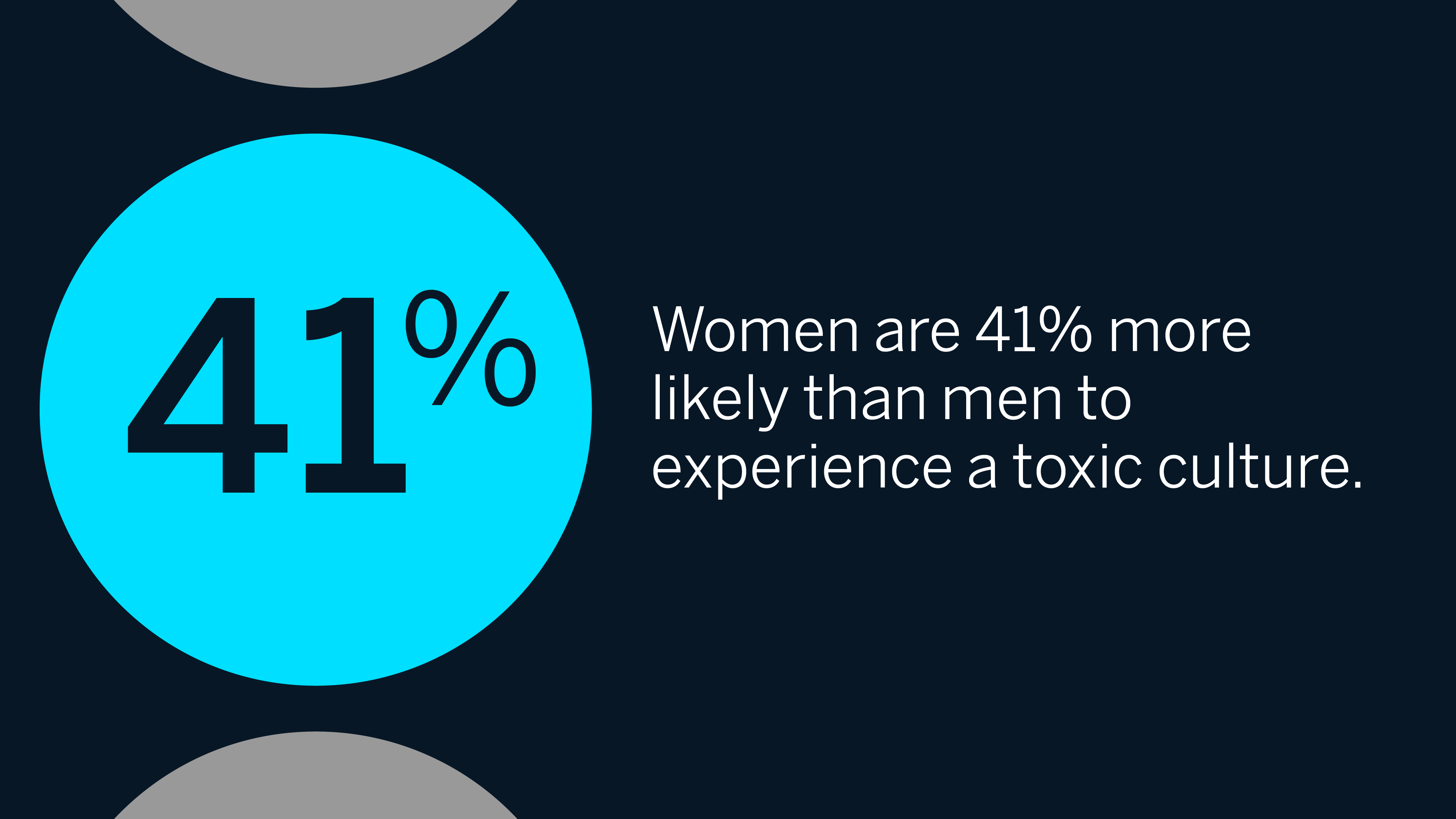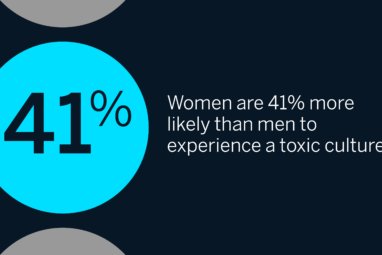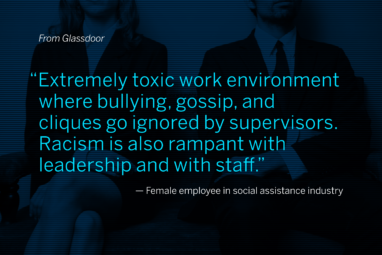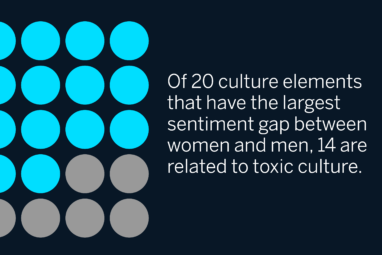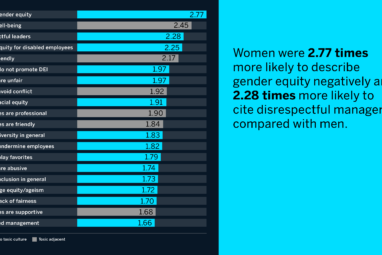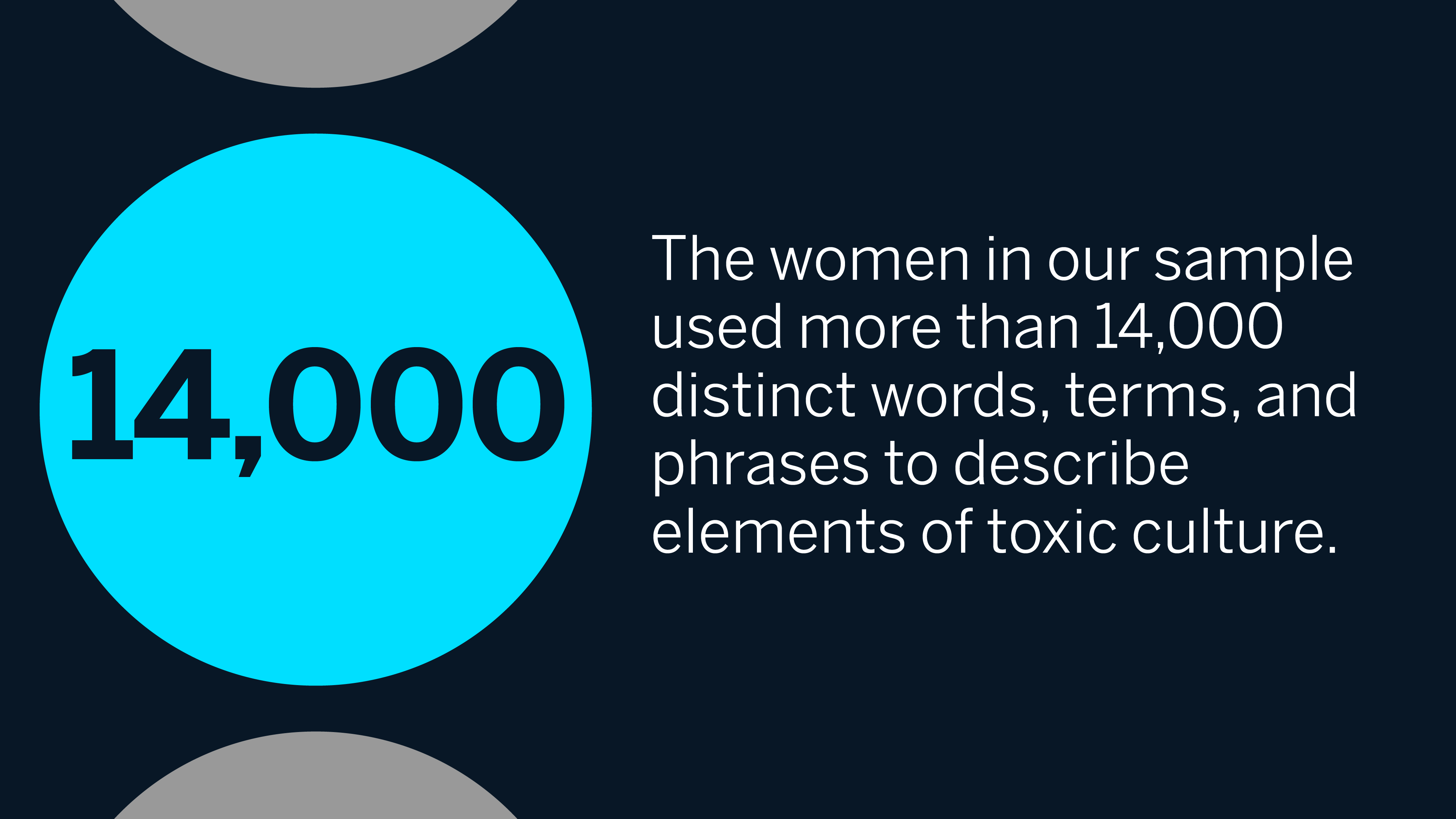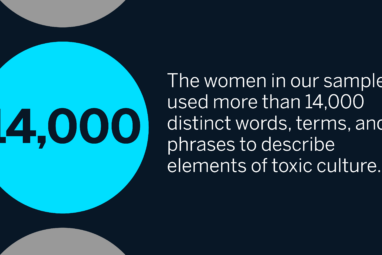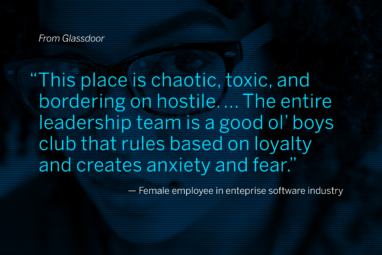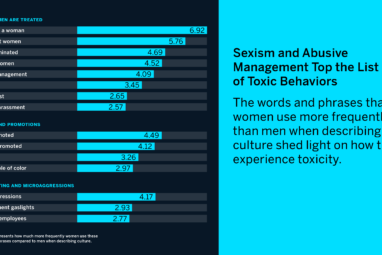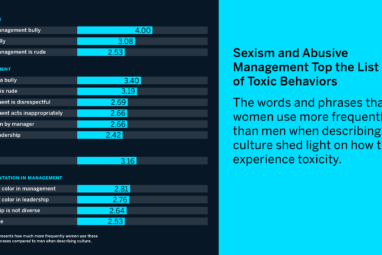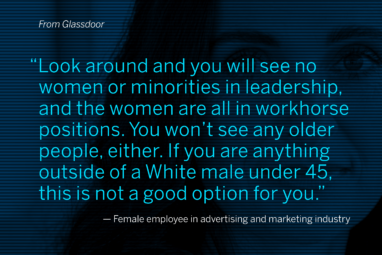The Toxic Culture Gap Shows Companies Are Failing Women
Research shows that women are 41% more likely to experience toxic workplace culture than men.
Topics
Measuring Culture

According to the most recent “Women in the Workplace” report from LeanIn.Org and McKinsey, the gap between men and women leaving their jobs is the largest it has been since the report was first published eight years ago.1 For every female director who is promoted, two women at the same level of seniority choose to quit. The exodus of female leaders, which has been dubbed the Great Breakup, is attributable in part to the persistent gap in pay between men and women.
Unequal compensation remains a critical pain point for many women, but corporate culture can exert an even more profound influence on how they experience the workplace. According to Rachel Thomas, CEO of LeanIn.Org and a coauthor of the report, women are leaving companies that fail to deliver on “the cultural elements of work that are critically important to them.”2
Get Updates on Transformative Leadership
Evidence-based resources that can help you lead your team more effectively, delivered to your inbox monthly.
Please enter a valid email address
Thank you for signing up
Which elements of corporate culture are most critical to women? And what are the most important cultural shortcomings causing women to head for the exits? To shed light on these questions, we analyzed the language that 3 million U.S. employees used in Glassdoor reviews to describe their employer between 2016 and 2021.3 Of the reviews that included self-reported gender, 51% identified as male and 49% as female.4 (Less than 0.2% of respondents chose “other” or “prefer not to state.”5)
We classified employee comments into nearly 200 fine-grained topics related to corporate culture, leadership, and other features that shape the employee experience. We aggregated multiple topics into two dozen broader themes. The theme “compensation and benefits,” for example, includes a dozen more-specific topics, including salary, variable compensation, signing bonuses, health benefits, and tuition reimbursement.
We measured how frequently men and women mentioned each topic and theme, as well as how positively or negatively they talked about them. To better understand how the situation has changed since the beginning of the COVID-19 pandemic, we also analyzed a subset of 600,000 reviews from 2020 through 2021, and we used the post-COVID-19 data set for most of the analyses that follow.6 Our sample includes reviews from all employers — large and small, across industries and organizational forms.
In the figure below (based on the post-pandemic data), the vertical axis plots the percentage of women who mentioned a topic in their Glassdoor reviews. The horizontal axis shows how much more positively or negatively women described a topic compared with men. Nearly half of women mentioned compensation and benefits, for example, and on average their comments were 89% as positive as those of men on that theme.
Women spoke more negatively than men about most elements of culture, including work-life balance and collaboration. The largest gap between the genders, however, is for toxic culture, which we define as a workplace culture that is disrespectful, noninclusive, unethical, cutthroat, or abusive.7
Toxic culture is not only an outlier in terms of the sentiment gap between women and men; it also imposes high costs on organizations and individuals. In an earlier study, we found that a toxic culture was 10 times more powerful than compensation in predicting attrition during the first six months of the so-called Great Resignation.8 Even if they don’t quit, employees in toxic environments are more likely to disengage from their work, exert less effort, and bad-mouth their employer to others.9
More importantly, toxic cultures exact a dreadful toll on their victims. Sustained exposure to a toxic culture increases the odds that employees will suffer from anxiety, depression, burnout, and serious physical health issues.10 As Brené Brown noted in the Dare to Lead podcast episode in which we discussed our research, toxicity affects employees on a deeper emotional level than most other elements of the employee experience.
Quantifying the Gender Gap in Toxic Culture
The destructive consequences of toxicity are not borne equally by all employees. Over the five years from 2016 to 2021, women were 35% more likely to negatively mention toxic culture in their Glassdoor reviews compared with men. The pandemic appears to have widened the toxic culture gender gap, and women were 41% more likely to suffer toxicity in the workplace in the first year after the onset of COVID-19.
One possible explanation for the toxic culture gender gap is that women are more heavily represented in certain industries (early education, health and beauty) or occupations (nursing, social work) where both men and women experience higher levels of toxicity. To isolate the impact of gender, we analyzed a range of demographic factors — including occupation, industry, length of employment and, of course, gender — to estimate their distinctive contributions in predicting whether an employee experienced a toxic workplace.11
Controlling for other demographic features, gender was the second most important predictor of whether an employee mentioned toxicity in their review. (The most powerful predictor was whether a review was written by a former employee, which is not surprising since employees are much more likely to leave toxic cultures.)
Another way to assess the toxic culture gap is to see how topics related to toxicity rank among all 196 topics we measured in terms of the sentiment gap between men and women. Our measure of toxic culture consists of 25 granular topics, such as racial equity, gender equity, and leaders playing favorites, that highlight a distinctive element of toxicity.
Understanding the Toxic Culture Gender Gap
Understanding the Toxic Culture Gender Gap
Understanding the Toxic Culture Gender Gap
backWe ranked the 20 topics with the largest sentiment gaps between women and men and found that gender equity had the biggest gap among all topics we measured. Women were 2.8 times more likely than men to speak negatively about sexual bias, discrimination, or gender-related exclusion in the workplace.
Topics related to toxic culture dominate the list of cultural components with the largest sentiment gaps between women and men. Fourteen of the 20 cultural elements with the largest sentiment gaps are components of our toxic culture measure. Other topics with the largest culture gaps — including mental well-being, supportive colleagues, and supportive leaders — are related to toxicity as well. The bottom line: Any way you cut the data, there is a yawning gap between women and men when it comes to toxic workplace culture.
Understanding Which Elements Drive the Toxic Culture Gender Gap
Organizing the data by the five dimensions of toxicity illustrates that women’s experience of toxicity extends beyond gender inequity. The figure below plots the gender gap for the 25 topics we use to measure toxic culture, organized into noninclusive, disrespectful, cutthroat, abusive, and unethical. (See “The Culture Gap Extends to All Elements of Toxic Culture.”) Of course, these topics overlap with one another — for instance, a lack of inclusivity reflects a lack of respect — which is why we aggregated them when measuring toxicity.
When it comes to lack of inclusivity, women have a more negative assessment of whether their employers provide a fair and inclusive environment for other demographic groups, including people of color, members of the LGBTQ community, and employees who are disabled or subject to ageism.
Women also speak more negatively about exclusion that may or may not be linked to an individual’s identity, including leaders who are unfair or play favorites, or a workplace environment of cronyism or unfairness. The women in our sample used more than 14,000 distinct words, terms, and phrases to describe elements of a toxic culture. The two most frequently mentioned were favoritism and clique.
The second-largest sentiment gap relates to whether women feel disrespected by managers. Our previous research has found that a perceived lack of respect is the single strongest predictor of how employees rate their company on Glassdoor.12 The difference between how women and men experience inclusivity and disrespect also emerges when we look at the specific terms that women used more than men when describing toxic culture. (See “How Women Describe Toxic Culture in Companies.”)
How Women Describe Toxic Culture in Companies
How Women Describe Toxic Culture in Companies
How Women Describe Toxic Culture in Companies
backMany of the words and phrases that women used more frequently described a range of mistreatment, including microaggressions, gaslighting, and unfair hiring and promotion decisions, as well as outright misogyny, sexism, and sexual harassment. Women also were much more likely to describe management and senior executives as bullying, rude, disrespectful, acting inappropriately, and racist.
Women and men discussed one element of toxic culture — unethical behavior — with roughly the same frequency. Why is the gender gap so much smaller for unethical behavior compared to the other four dimensions of toxic culture? While our data does not allow us to say definitively, after reading hundreds of gut-wrenching reviews, we believe the difference may arise from power imbalances in the workplace.
The other four elements of toxicity are all forms of employee mistreatment, where managers or colleagues hurt other employees who may lack the power to challenge this behavior. To the extent that women are denied power in organizations, they are more likely to find themselves on the receiving end of these toxic behaviors than men.
Unethical behavior, in many cases, is more about flouting the rules than mistreating less-powerful colleagues. When employees or managers evade regulatory requirements, company rules, or ethical guidelines, their behavior — while toxic — is not necessarily directed at other individuals the same way abusive management or disrespect are. This might explain why women and men mentioned unethical behavior at more similar rates.
How the Toxic Culture Gender Gap Varies by Industry and Occupation
The toxic culture gender gap varied significantly across the 155 occupations we studied.13 Chefs exhibit the largest gender gap in toxic culture in our data, and women chefs were nearly twice as likely to discuss toxic culture in their reviews. Our data suggests that the toxic kitchen cultures depicted in television series like The Bear and Sweetbitter hit pretty close to the mark.
The toxic culture gap does not appear to diminish with seniority. Across self-reported C-level roles, women were 53% more likely to experience toxicity than men. (Recall that the average across all job categories is 41%.) Nor are knowledge workers or professionals immune to the toxic culture gap, with attorneys, management consultants, product managers, and electrical engineers all reporting higher-than-average toxic culture gaps. (See “The Gender Gap in Toxic Culture Across Occupations.”)
Consistent with earlier research, we find that the toxic culture gap is correlated with the mix of male and female employees in an occupation.14 On average, a higher percentage of male employees in an occupation is associated with a slightly larger gender gap in toxic culture.15 Some of the largest gender gaps are seen in fields with a high percentage of male employees, including electrical engineering, the military, and automotive repair.
Fourteen of the 16 occupations with the smallest gaps are jobs with a high percentage of female employees, including child care, psychology, social work, and nursing. Among roles with the largest toxic culture gender gaps, only three — eye care professionals, nonphysician medical practitioners, and models — are held by a larger proportion of women than men. When women dominate an occupation, in other words, the toxic culture gap shrinks dramatically.
The gap between how frequently women and men experience toxic culture also varies by industry.16 The four sectors with the largest toxic culture gender gaps were retail, transportation, investment services, and restaurants. Three of those sectors employ a high percentage of hourly workers, including retail representatives, drivers, and food service employees, which highlights the challenges women face with toxicity in blue-collar professions.
Investment services (including brokerages, venture capital, private equity, investment banking, and asset management) stand out among white-collar industries for the size of the gap between men and women experiencing toxic culture. It’s worth noting that more-traditional financial institutions, including insurance firms, banks, and credit unions, all have gaps below the average of all industries.
National Equal Pay Day, which falls on March 14 in 2023, highlights the difference in average compensation by marking the number of extra days a woman has to work to earn as much as her male counterpart. For women of color, Equal Pay Day occurs even later in the year.
In our work advising companies, however, we consistently find that corporate culture and leadership are much stronger predictors of employee satisfaction, engagement, and attrition than compensation is. Among all of the elements of culture, moreover, toxicity exerts a disproportionate impact on employees’ experience as well as their mental and physical health.
And the gap between men and women regarding toxic culture is even larger than differences in their pay. An Equal Culture Day that represented the additional days of toxic culture endured by women would occur on May 30, two and a half months after Equal Pay Day.17 To achieve gender equity, leaders must address the toxic culture gap as well as discrepancies in pay.
The severity and magnitude of the toxic culture gender gap is unequivocally bad news, but there is good news as well: There are concrete steps that leaders can take to narrow the gap relatively quickly. In our work helping companies improve corporate culture, we have seen leaders successfully address the toxic culture gap between women and men, often making progress within a few quarters.
In our article “How to Fix a Toxic Culture,” we laid out dozens of evidence-based ways that leaders at every level — from the C-suite to front-line supervisors — can root out toxicity. Many of these interventions can deliver immediate improvements.
We have found, for example, that toxicity is often concentrated in specific teams, divisions, or regions, within otherwise healthy cultures. Leaders can achieve rapid gains by measuring microcultures throughout their organizations, identifying pockets of toxicity, and taking targeted actions to improve these subcultures.
Organizations can address toxic culture, but systematic and sustained improvements require top executives and corporate boards to commit to change. Toxic culture is a cancer that disproportionately affects women but one that leaders can treat quickly and effectively if they choose to do so. We hope that this article contributes to existing research to make a compelling case for top executives and board members to make this commitment.
References
1. G. Cardazone, M. Cooper, B. Edwards, et al., “Women in the Workplace 2022,” PDF file (San Francisco and New York: LeanIn.Org and McKinsey, October 2022), www.mckinsey.com.
2. Rachel Thomas, quoted in R. Molla, “Women in Leadership Are Leaning Out (and Into a Better Job),” Vox, Oct. 18, 2022, www.vox.com.
3. The full sample consists of 3.3 million U.S. employee Glassdoor reviews from July 2016 through July 2021. Jason Sockin compared Glassdoor ratings and salary information to comparable measures from three government surveys and found that the Glassdoor data is highly correlated with official measures of the labor market as a whole. See J. Sockin, “Show Me the Amenity: Are Higher-Paying Firms Better All Around?” working paper 9842, CESifo, Munich, Nov. 5, 2021.
4. Seventy-seven percent of all respondents identified their gender in their reviews.
5. We omitted these reviews because this category conflated “other” with “prefer not to state,” and because the absolute number of reviews in this category was too small to produce robust results when we analyzed subsets of data such as gender by occupation or industry.
6. In July 2021, Glassdoor stopped including gender identifiers in the data they share with researchers, so the post-COVID-19 data set consists of 594,239 U.S. reviews by respondents who identified as male or female between April 2020 and July 2021.
7. In an earlier study, we identified five elements of culture that best predict whether an employee will rate their organization in extremely negative terms. See D. Sull, C. Sull, W. Cipolli, et al., “Why Every Leader Needs to Worry About Toxic Culture,” MIT Sloan Management Review, March 16, 2022, https://sloanreview.mit.edu. The five elements of toxic culture map closely to a large body of research in psychology on the most harmful elements of a workplace environment, often referred to as “workplace mistreatment” or “employee victimization.” See J. Yao, S. Lim, C. Guo, et al., “Experienced Incivility in the Workplace: A Meta-Analytical Review of Its Construct Validity and Nomological Network,” Journal of Applied Psychology 107, no. 2 (February 2022): 193-220.
8. D. Sull, C. Sull, and B. Zweig, “Toxic Culture Is Driving the Great Resignation,” MIT Sloan Management Review, Jan. 11, 2022, https://sloanreview.mit.edu.
9. J. Sockin, “Show Me the Amenity”; V. Gandhi and J. Robison, “The ‘Great Resignation’ Is Really the ‘Great Discontent,’” Gallup, July 22, 2021, www.gallup.com; and Sull et al., “Why Every Leader Needs to Worry About Toxic Culture.”
10. J.M. Robbins, M.T. Ford, and L.E. Tetrick, “Perceived Unfairness and Employee Health: A Meta-Analytic Integration,” Journal of Applied Psychology 97, no. 2 (March 2012): 235-272; J. Goh, J. Pfeffer, and S. Zenios, “The Relationship Between Workplace Stressors and Mortality and Health Costs in the United States,” Management Science 62, no. 2 (February 2016): 608-628; and “The High Cost of a Toxic Workplace Culture: How Culture Impacts the Workforce — and the Bottom Line,” PDF file (Alexandria, Virginia: Society for Human Resource Management, September 2019), https://pmq.shrm.org.
11. Our analysis included a total of 366 demographic features, including 159 occupations, 144 industries, type of employer (public, private, etc.), employment status (part-time, full-time, etc.), length of employment, size of employer, region, gender, and whether the review was written by a current or former employee. To identify which demographic attributes were most important in predicting whether an employee would mention toxic culture, we used an XGBoost model and calculated the SHAP (Shapley additive explanations) value for each demographic feature. To normalize the results, we divided each demographic feature’s SHAP value by the SHAP value for the average of all features in the model. For a useful overview of SHAP values to estimate feature importance, see S.M. Lundberg, G. Erion, H. Chen, et al., “From Local Explanations to Global Understanding With Explainable AI for Trees,” Nature Machine Intelligence 2, no. 1 (January 2020): 56-67. This approach is analogous to a factorial analysis of variance but has the advantage that the SHAP values are easily interpretable as the percentage of total variance explained by the model.
12. See D. Sull and C. Sull, “10 Things Your Corporate Culture Needs to Get Right,” MIT Sloan Management Review, Sept. 16, 2021, https://sloanreview.mit.edu; and Sockin, “Show Me the Amenity.”
13. For this analysis, we used the full data set of reviews from 2016 to 2021 to maximize the number of occupations by gender pairings (162 x 2) that met a threshold number of reviews required for reliable free-text analysis. We dropped any occupation with fewer than 20 reviews by either men or women and by students, which left a sample of 155 occupations.
14. We estimated the gender mix of each occupation as the ratio of reviews written by women to the sum of reviews written by women and men. A Pew Research Center survey conducted in 2017 found that 38% of women in majority-male workplaces agreed that women are treated fairly in recruitment and hiring, compared with 79% who agreed with that assessment in majority-female workplaces. See K. Parker, “Women in Majority-Male Workplaces Report Higher Rates of Gender Discrimination,” Pew Research Center, March 7, 2018, www.pewresearch.org.
15. The correlation between the gender gap for each occupation and its estimated mix of male and female employees is 0.26 (p-value = 0.001).
16. For this analysis, we used the full data set of reviews from 2016 to 2021 to maximize the number of industries by gender pairings (142 x 2) that met a threshold number of reviews required for reliable free-text analysis. We dropped any industries below a threshold number of reviews for either men or women, and we dropped universities because of the high percentage of reviews by students, which reduced the number of included industries from 142 to 117.
17. To calculate this date, we multiplied 41% (the increased likelihood that women experience toxic culture) by 365 days in a year, which equals 150 days. In 2022, May 30 was the 150th day of the year.

